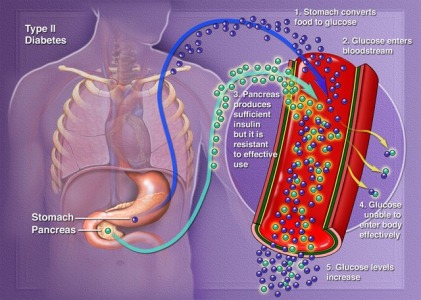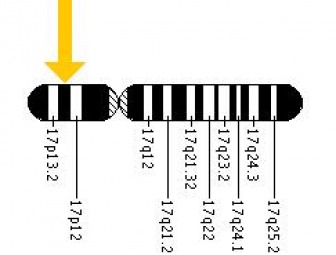This web page was produced as an assignment for Genetics 677, an undergraduate course at UW-Madison.
Diabetes
About 8% of the population have diabetes and about 19% are in a pre-diabetic state. Diabetes is the 7th leading cause of death in the United States. Associated with diabetes are 2-4 fold higher risk of stroke and heart disease. Also, 75% of patients with diabetes show an elevated blood pressure. About 20,000 new cases of blindness are reported each year in USA due to diabetes. Diabetes also accounted for almost half of the kidney failures reported in 2005. Around 60-70% of the people with diabetes have mild to severe nervous system damage. Another complication is amputation, more than 60% of nontraumatic amputations were due to diabetes [1]. There are three kinds of diabetes, Type 1 (Juvenile), Type 2 (noninsulin-dependent diabetes) and Gestational. This project will deal only with Type 2 diabetes.
About 8% of the population have diabetes and about 19% are in a pre-diabetic state. Diabetes is the 7th leading cause of death in the United States. Associated with diabetes are 2-4 fold higher risk of stroke and heart disease. Also, 75% of patients with diabetes show an elevated blood pressure. About 20,000 new cases of blindness are reported each year in USA due to diabetes. Diabetes also accounted for almost half of the kidney failures reported in 2005. Around 60-70% of the people with diabetes have mild to severe nervous system damage. Another complication is amputation, more than 60% of nontraumatic amputations were due to diabetes [1]. There are three kinds of diabetes, Type 1 (Juvenile), Type 2 (noninsulin-dependent diabetes) and Gestational. This project will deal only with Type 2 diabetes.

Savvy Health & Fitness. Retrieved from: http://savvyhealthfitness.com/
Type 2 diabetes, also known as noninsulin-dependent diabetes mellitus (NIDDM), is the most common kind of diabetes. It is more common among African Americans, Latinos, Native Americans, Asian Americans, Pacific Islanders, and the aged population. In this disease, the pancreas does not produce enough insulin to stimulate the cells to take in glucose, or the cells are not able to recognize insulin [1]. In any way, the cells cannot take up glucose, and thus glucose starts to build up in the blood. The high concentrations may be harmful for the eyes, kidneys, nerves, and heart [1]. Also because the cells are not able to take up glucose they starve. All the sugars and starches we eat are broken down into glucose which is then sent through the blood to all tissues in the body. Then the cells in the tissues take the glucose and harvest usable energy from it. However if there is no insulin or the cells are not able to respond to it, then the cells are not able to take up the glucose and harvest energy from it. Below is an animation giving an overview of diabetes Type 2.
GLUT4

Chromosome 17. Retrieved from http://ghr.nlm.nih.gov
Type 2 diabetes has genetic and environmental factors that increase the chances of an individual of getting it. Among the environmental factors are high cholesterol and obesity, and among the genetic factors are genes involved in glucose metabolism or glucose intake signaling such as GLUT4. The GLUT4 gene (aka SLC2A4) codes for a 509 aminoacid long protein called GLUT4 also for glucose transporter 4 [2]. There are several glucose transporters (such as GLUT1, GLUT2, etc) in the cell that help keep the blood glucose level low, but GLUT4 is the only one that responds to insulin. GLUT4 is in the family of solute carriers and is responsible for facilitating the transport glucose into the cells in response to insulin [3]. For this reason, mutations in GLUT4 have been associated with Type 2 diabetes [4]. The GLUT4 gene has been mapped to the region 13 in the short arm of chromosome 17 (17p13) [5]. Also it has been determined that the gene is 6314 bp long and contains 11 exons [4].
In this project I will analyse both popular press articles and scientific literature to compare and contrast them. Also I am going to do some comparative analysis with the protein and DNA sequences, find homologues in other species, and propose a phylogeny. A map of the protein network will also be generated to present the known protein interactions of GLUT4 in order to explain the molecular mechanisms of its function. Finally I am going to review the literature of what has been done so far in terms of genomics in order to get insights of what can be done in the future to advance the field.
References
1. American Diabetes Association. http://www.diabetes.org/
2. Entrez Protein. http://www.ncbi.nlm.nih.gov/protein/
3. Garvey, W. T.; Maianu, L.; Zhu, J.-H.; Brechtel-Hook, G.; Wallace, P.; Baron, A. D. Evidence for defects in the trafficking and translocation of GLUT4 glucose transporters in skeletal muscle as a cause of human insulin resistance. J. Clin. Invest. 101: 2377-2386, 1998.
4. Genetics Home Reference. http://ghr.nlm.nih.gov
5. Fan, Y.-S.; Eddy, R. L.; Byers, M. G.; Haley, L. L.; Henry, W. M.; Kayano, T.; Shows, T. B.; Bell, G. I. Assignment of genes encoding three human glucose transporter/transporter-like proteins (GLUT4, GLUT5 and GLUT6) to chromosomes 17, 1 and 5, respectively. Cytogenet. Cell Genet. 51: 997 only, 1989.
2. Entrez Protein. http://www.ncbi.nlm.nih.gov/protein/
3. Garvey, W. T.; Maianu, L.; Zhu, J.-H.; Brechtel-Hook, G.; Wallace, P.; Baron, A. D. Evidence for defects in the trafficking and translocation of GLUT4 glucose transporters in skeletal muscle as a cause of human insulin resistance. J. Clin. Invest. 101: 2377-2386, 1998.
4. Genetics Home Reference. http://ghr.nlm.nih.gov
5. Fan, Y.-S.; Eddy, R. L.; Byers, M. G.; Haley, L. L.; Henry, W. M.; Kayano, T.; Shows, T. B.; Bell, G. I. Assignment of genes encoding three human glucose transporter/transporter-like proteins (GLUT4, GLUT5 and GLUT6) to chromosomes 17, 1 and 5, respectively. Cytogenet. Cell Genet. 51: 997 only, 1989.
Where are you visiting from?
Carlos Gil del Alcazar, [email protected], last updated on 2/8/10
